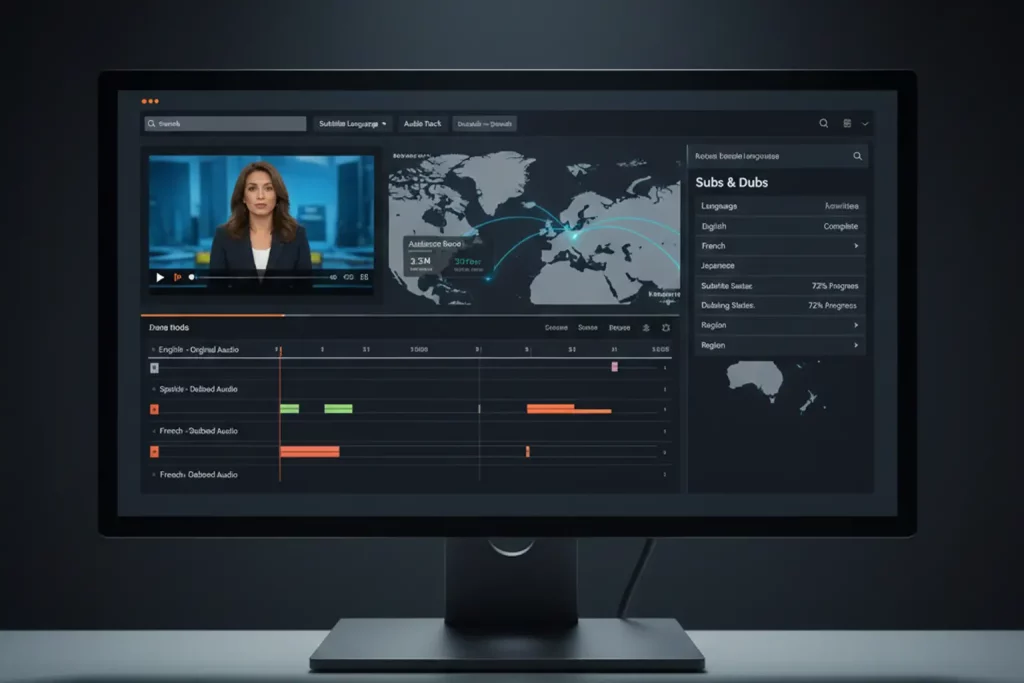Autometadata is revolutionizing the broadcasting industry by transforming how broadcasters manage and utilize metadata. Autometadata refers to the automated generation, tagging, and managing metadata for various content formats. Its importance lies in the significant efficiencies and accuracy it brings to broadcasting operations. By automating metadata processes, broadcasters can reduce manual labor, enhance content discoverability, and increase the accuracy and consistency of metadata tagging. This technology streamlines operations, making managing vast content easier while ensuring high-quality metadata standards.
The Role of Autometadata in Modern Broadcasting
Autometadata is pivotal in streamlining workflows and managing extensive content libraries in today’s broadcasting landscape. Traditional methods of metadata management are often labor-intensive and prone to human error. Autometadata, however, uses advanced algorithms to process large volumes of content quickly and accurately.
Key Benefits for Broadcasters:
- Improved Searchability and Content Management: Automating metadata tagging makes content more searchable and easier to manage, leading to quicker retrieval times and better content organization.
- Enhanced Workflow Efficiency: Automation drastically reduces the time and effort required to tag and index content, allowing broadcasters to focus on more strategic tasks.
- Consistency and Accuracy: Automated systems ensure a high level of consistency in metadata tagging, reducing errors and improving the overall quality of the metadata.
MetadataIQ and Autometadata
MetadataIQ is a leading tool that supports and enhances autometadata processes in broadcasting. It provides a comprehensive solution for managing and automating metadata. Its features are designed to improve content discoverability, streamline workflows, and ensure metadata accuracy.
- Automated Tagging: MetadataIQ’s automated tagging feature ensures consistent and accurate metadata across all content.
- Real-Time Monitoring: The tool offers real-time monitoring capabilities, allowing broadcasters to manage content more effectively.
- Data Analytics: MetadataIQ provides advanced data analytics, giving broadcasters insights into content performance and viewer engagement.
Ready to experience the future of Metadata? Schedule a free demo today!
Key Benefits of Autometadata
Enhanced Content Discoverability
One of the most significant advantages of auto metadata is its impact on content discoverability. Automated tagging and indexing make finding specific content easier for internal teams and audiences. This is particularly important in a digital age where the sheer volume of content can be overwhelming. With precise and consistent metadata, content becomes more accessible, leading to higher viewer engagement and satisfaction.
Streamlined Workflow and Reduced Manual Labor
Manual metadata tagging can be a painstaking process, often requiring extensive human resources. Autometadata alleviates this burden by automating repetitive and time-consuming tasks. This speeds up the workflow and allows human resources to be allocated to more creative and strategic roles within the broadcasting organization.
Improved Accuracy and Consistency in Metadata Tagging
Human metadata tagging errors can lead to content retrieval and management issues. Autometadata systems produce consistent and accurate tags, ensuring the metadata remains reliable over time. This consistency is crucial for maintaining a high-quality library and efficient content management.
Implementing Autometadata in Your Broadcasting Workflow
Integrating autometadata into existing broadcasting workflows requires careful planning and execution. Here are steps to ensure a smooth implementation:
Steps to Integrate Autometadata
- Assessment and Planning: Evaluate your current metadata management processes and identify areas where automation can be most beneficial.
- Choose the Right Tools: Select autometadata tools and software that fit your organization’s needs. Consider factors such as ease of integration, scalability, and support.
- Pilot Testing: Conduct a pilot test to ensure the chosen tool works well with your existing systems and meets your requirements.
- Training and Onboarding: Train your team to use the new tools effectively and ensure everyone understands the system’s benefits and functionalities.
- Full Deployment: Once the pilot testing is successful, proceed with the full deployment of the autometadata system.
- Continuous Monitoring and Improvement: Regularly monitor the performance of the autometadata system and make necessary adjustments to optimize its efficiency.
Best Practices for a Smooth Implementation Process
- Stakeholder Involvement: Involve key stakeholders from the beginning to ensure buy-in and address potential concerns.
- Clear Objectives: Define clear objectives and success metrics for the implementation process.
- Change Management: To help staff adapt to new workflows and technologies and prepare for change management.
- Quality Assurance: Implement quality assurance processes to check the accuracy and performance of the automated system regularly.
Real-World Applications of Autometadata
Autometadata has numerous real-world applications in broadcasting, from content indexing to archiving and retrieval.
Examples of Uses
- Content Indexing: Automated tagging helps categorize content accurately, making it easier to find and use in the future.
- Archiving: Historical content can be tagged retroactively, enhancing its discoverability and usefulness.
- Retrieval: With precise metadata, retrieving specific content becomes quicker and more efficient.
Case Studies
- Case Study 1: A national broadcaster implemented an auto metadata system to manage its vast archive. As a result, the time taken to retrieve content was reduced by 40%, significantly improving its operational efficiency.
- Case Study 2: A regional news station used auto metadata to tag real-time news footage. This improved their newsroom workflow and their ability to respond quickly to viewer requests for specific segments.
Overcoming Challenges in Autometadata Adoption
While the benefits of automation are clear, the adoption process can present several challenges.
Common Challenges
- Integration Issues: Integrating new autometadata tools with existing systems can be complex and may require significant technical expertise.
- Cost: The initial investment in automation tools and systems can be high, which may be a barrier for smaller broadcasters.
- Resistance to Change: Staff may only accept new technologies if they are accustomed to manual processes.
Solutions and Strategies
- Technical Support: Engage with vendors who offer robust technical support to assist with integration issues.
- Cost-Benefit Analysis: Conduct a cost-benefit analysis to demonstrate the long-term savings and efficiencies gained from autometadata.
- Training Programs: Implement comprehensive training programs to help staff understand and embrace the benefits of automation.
The Future of Autometadata in BroadcastingDriven by emerging trends and technological advancements
Autometadata is poised to play an even more significant role in the future of broadcasting.
Emerging Trends and Technologies
- Artificial Intelligence: The integration of AI is expected to enhance the capabilities of automated systems, making them more intuitive and accurate.
- Machine Learning: Machine learning algorithms will continue to improve, leading to better pattern recognition and more efficient metadata tagging.
- Big Data Analytics: The application of big data analytics will provide deeper insights into content usage and viewer preferences, further enhancing content management.
Predictions for its Impact on the Broadcasting Industry
As auto metadata systems become more sophisticated, their impact on the broadcasting industry will likely include:
- Enhanced Viewer Experience: Improved content discoverability will improve viewer experience.
- Operational Efficiency: Automation will continue streamlining workflows, reducing operational costs, and improving efficiency.
- Competitive Advantage: Broadcasters who embrace autometadata will gain a competitive edge through better content management and faster response times.
Conclusion
In summary, autometadata is a transformative technology in the broadcasting industry, offering numerous benefits, such as enhanced content discoverability, streamlined workflows, and improved metadata accuracy. While adopting autometadata may present challenges, the long-term advantages far outweigh the initial hurdles. Tools like MetadataIQ are crucial in facilitating the implementation and optimization of autometadata processes. As the industry continues to evolve, embracing autometadata will be essential for broadcasters seeking to maintain a competitive edge and improve their operational efficiency.
Digital Nirvana: Empowering Knowledge Through Technology
Digital Nirvana stands at the forefront of the digital age, offering cutting-edge knowledge management solutions and business process automation.
Key Highlights of Digital Nirvana –
- Knowledge Management Solutions: Tailored to enhance organizational efficiency and insight discovery.
- Business Process Automation: Streamline operations with our sophisticated automation tools.
- AI-Based Workflows: Leverage the power of AI to optimize content creation and data analysis.
- Machine Learning & NLP: Our algorithms improve workflows and processes through continuous learning.
- Global Reliability: Trusted worldwide for improving scale, ensuring compliance, and reducing costs.
Book a free demo to scale up your content moderation, metadata, and indexing strategy for your media assets with minimal effort and get a firsthand experience of Digital Nirvana’s services.
FAQs:
1. What is autometadata in broadcasting?
Autometadata refers to the automated generation, tagging, and management of metadata for various content formats, enhancing efficiency and accuracy in broadcasting operations.
2. How does autometadata improve content discoverability?
Autometadata improves content discoverability by ensuring precise and consistent metadata tagging, making it easier for internal teams and audiences to find specific content.
3. What are the benefits of autometadata for broadcasters?
Key benefits include enhanced content discoverability, streamlined workflows, reduced manual labor, improved accuracy and consistency in metadata tagging, and better content management.
4. What challenges might broadcasters face when adopting autometadata?
Common challenges include integration issues with existing systems, high initial investment costs, and resistance to change from staff accustomed to manual processes.
5. How can MetadataIQ support autometadata processes?
MetadataIQ supports autometadata by providing automated tagging, real-time monitoring capabilities, and advanced data analytics to improve content management and viewer engagement.




